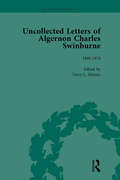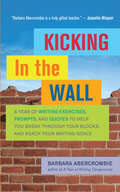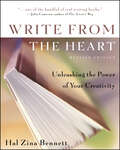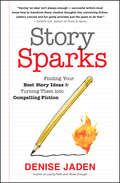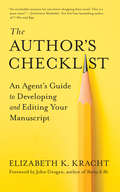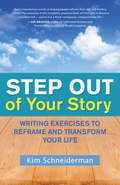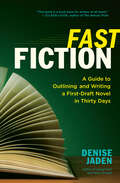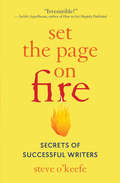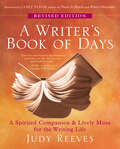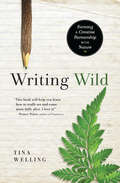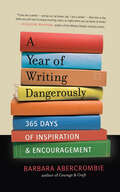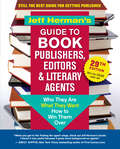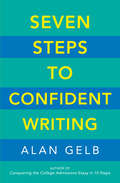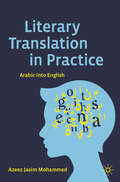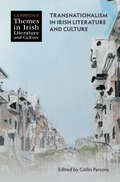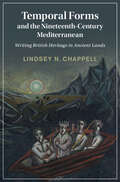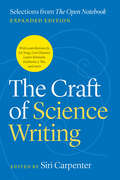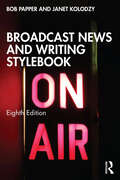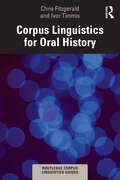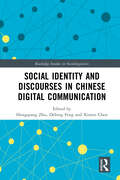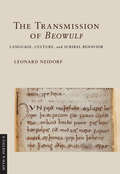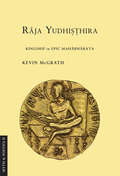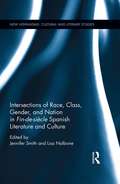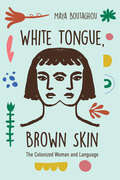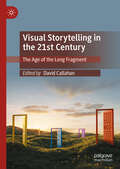- Table View
- List View
The Uncollected Letters of Algernon Charles Swinburne Vol 1
by Terry L MeyersThese three volumes of letters by Algernon Charles Swinburne add approximately 600 letters by this poet that were not available when Cecil Y. Lang published his six volume edition of Swinburne's letters. The volumes also contain a selection of several hundred other letters addressed to Swinburne.
Kicking In the Wall: A Year of Writing Exercises, Prompts, and Quotes to Help You Break Through Your Blocks and Reach Your Writing Goals
by Barbara AbercrombieWhen Patti Smith was plagued with writer’s block — “scattered and stymied, surrounded by unfinished songs and abandoned poems” — playwright Sam Shepard advised her, “When you hit a wall, just kick it in.” In these pages, Abercrombie shows readers how to do just that. Like a workout with a top trainer, her writing exercises warm up, stretch, and build creative muscle. Quotes from famous writers inspire each day’s exercise. Though Abercrombie says readers need only commit five minutes to each exercise, she writes, “I’ve seen novels, memoirs, and many essays get started” in those five minutes, “and a lot ended up being published.” Her playful, powerful method is ideal — maybe even essential — fuel for writers trying to get off the starting block, persevere through challenges, and cross their personal creativity finish lines.
Write from the Heart: Unleashing the Power of Your Creativity
by Hal Zina BennettIn his first edition of Write from the Heart, Hal Zina Bennett presented a spiritual approach to writing that showed both beginners and seasoned authors how to overcome blocks, unleash their creative voice, and see their books in print. In this edition, he gives readers an even more interactive experience by incorporating exercises he's developed during his many years conducting workshops. An all-new chapter on supportive critiquing shows readers how to make contacts in the all-important community of writers and how to get help with the process of writing and refining. This revised edition also includes an updated section on getting published that addresses print-on-demand, electronic books, and the Internet.
Story Sparks: Finding Your Best Story Ideas and Turning Them into Compelling Fiction
by Denise JadenFind rock-solid story ideas before you start writingAnyone who has been hamster-wheeling a story idea for years or has hundreds of pages exploring various approaches on their hard drive knows that there must be a better way. There is. Young adult novelist Denise Jaden shows exactly how to create the captivating stories that prevent dispiriting wasted time. Busting the "visitation from the muses" myth, she shows that inspiration is a skill writers can learn by understanding how story ideas work (or don't), fertilizing the ground for fresh and sound ideas, and moving swiftly through stuck points. Practical and inspiring, Jaden's approach celebrates the imaginative sparks that make innovations of all kinds possible while pinpointing the precise tools writers need to fan their unique creative flames.
The Author’s Checklist: An Agent’s Guide to Developing and Editing Your Manuscript
by Elizabeth K. KrachtAn Indispensable Guide for All Writers in All Genres The bad news: even really good manuscripts have weak spots that are enough to garner rejections from agents and publishers. The good news: most of these problems are easy to fix — once the writer sees and understands them. After several years of evaluating manuscripts, literary agent Elizabeth Kracht noticed that many submissions had similar problems, so she began to make a list of the pitfalls. The Author&’s Checklist offers her short, easy-to-implement bites of advice, illustrated by inspiring — and cautionary — real-world examples. Most aspiring authors yearn for a friend in book publishing. The Author&’s Checklist is just that.
Step Out of Your Story: Writing Exercises to Reframe and Transform Your Life
by Kim SchneidermanREFRAME YOUR STORY, RECLAIM YOUR LIFE Every day we relate stories about our highs and lows, relationships and jobs, heartaches and joys. But do we ever consider the choices we make about how to tell our story? In this groundbreaking book, Kim Schneiderman shows us that by choosing a version that values life lessons and meaningful personal victories we can redirect our energy and narrative toward our desires and goals. It presents character development workouts and life-affirming, liberating exercises for retelling our stories to find redemptive silver linings and reshape our lives. As both a therapist and a writer, Schneiderman knows the power of story. By employing the storytelling techniques she offers, you’ll learn to view your life as a work in progress and understand big-picture story lines in ways that allow you to easily steer your actions and relationships toward redefined — and realistic — “happy endings.”
Fast Fiction: A Guide to Outlining and Writing a First-Draft Novel in Thirty Days
by Denise JadenWriters flock to National Novel Writing Month (NaNoWriMo) each November because it provides a procrastination-busting deadline. But only a fraction of the participants meet their goal. Denise Jaden was part of that fraction, writing first drafts of two subsequently published novels in that tight time frame. In Fast Fiction, she shows other writers how to do what she did, step-by-step, writer to writer. To ensure success, her program begins a month before the month of drafting. During this prep period writers think through plot, theme, characters, setting, etc. Then Jaden provides day-by-day coaching for the thirty-day drafting period. After writers “race to the finish,” they are not left high and dry. Jaden's “After the Draft” revision tips allow writers to determine if a draft is not just workable but compelling, so that they don't waste months or years developing it. Her camaraderie and skill allow Jaden to both instruct and inspire.
Set the Page on Fire: Secrets of Successful Writers
by Steve O'KeefeDiscover the Tricks and Tools of the Pros Successful writers write, rather than just think about writing, talk about writing, or plan what they&’ll write when they get a cabin in the woods. Yet even accomplished writers sometimes get &“blocked,&” losing access to their in-the-zone writing mind. Steve O&’Keefe offers proven techniques and practices for jump-starting stalled ideas, honed during his many years of working in virtually every aspect of publishing. His innovative, often unconventional exercises will get you writing and accessing your own unique voice — a voice the world wants to read! Containing a career&’s worth of writing and publishing savvy, as well as the advice of expert authors gleaned from hundreds of interviews, Set the Page on Fire is the kind of nuts-and-bolts coaching and encouragement invaluable to novice and veteran writers alike.
A Writer's Book of Days: A Spirited Companion and Lively Muse for the Writing Life
by Judy ReevesFirst published a decade ago, A Writer's Book of Days has become the ideal writing coach for thousands of writers. Newly revised, with new prompts, up-to-date Web resources, and more useful information than ever, this invaluable guide offers something for everyone looking to put pen to paper — a treasure trove of practical suggestions, expert advice, and powerful inspiration. Judy Reeves meets you wherever you may be on a given day with: • get-going prompts and exercises • insight into writing blocks • tips and techniques for finding time and creating space • ways to find images and inspiration • advice on working in writing groups • suggestions, quips, and trivia from accomplished practitioners Reeves's holistic approach addresses every aspect of what makes creativity possible (and joyful) — the physical, emotional, and spiritual. And like a smart, empathetic inner mentor, she will help you make every day a writing day.
Writing Wild: Forming a Creative Partnership with Nature
by Tina WellingAlign Your Creative Energy with Nature’s “Everything we know about creating,” writes Tina Welling, “we know intuitively from the natural world.” In Writing Wild, Welling details a three-step “Spirit Walk” process for inviting nature to enliven and inspire our creativity.
A Year of Writing Dangerously: 365 Days of Inspiration and Encouragement
by Barbara AbercrombieIn this collection of anecdotes, lessons, quotes, and prompts, author and writing teacher Barbara Abercrombie provides a delightfully varied cornucopia of inspiration —nuts-and-bolts solutions, hand-holding commiseration, and epiphany-fueling insights from fellow writers, including Nobel and Pulitzer Prize winners and Abercrombie’s students who have gone from paralyzed to published.
Jeff Herman’s Guide to Book Publishers, Editors & Literary Agents, 29th Edition: Who They Are, What They Want, How to Win Them Over
by Jeff HermanIf you want to get published, read this book! Jeff Herman’s Guide unmasks nonsense, clears confusion, and unlocks secret doorways to success for new and veteran writers! This highly respected resource is used by publishing insiders everywhere and has been read by millions all over the world. Countless writers have turned to this book to figure out how to decipher the hidden codes to getting published. It reveals: • tools to discern and exploit the rapidly changing publishing environment • the crucial differences between independent houses and the “Big 5” publishers • hard truths about self-publishing • names, interests, and contact information of hundreds of agents and editors • how writers unwittingly disqualify themselves from the consideration they deserve, and how to optimize chances with agents • critical thinking skills for outside-the-box publishing strategies • the nuts and bolts of superior query letters and proposals • how to spot and avoid ever-more-prevalent scams • the value of “book doctors” and when to consider hiring them • what to do — and not do — once you’ve got an editor or publisher interested Herman’s book remains the go-to guide for everything anyone ever wanted to know about book publishing. Comprehensive index lists dozens of subjects and categories to help you find the perfect publisher or agent.
Seven Steps to Confident Writing
by Alan GelbNot everyone is a natural writer. In fact, most people don&’t think that much about writing until they&’re called upon to write something like an office memo or a wedding speech and find themselves paralyzed with self-doubt. Author and writing coach Alan Gelb specializes in helping anxious writers find their voice, drawing upon techniques that can improve anyone&’s writing, sometimes in a matter of days. His compact and easy-to-use guide demystifies the writing process and shows readers how to sculpt concise sentences, shape well-structured paragraphs, polish a final draft, and combat procrastination. Best of all, readers will see for themselves that writing is not an inborn talent but a skill that can be mastered with a bit of patience and perseverance.
Literary Translation in Practice: Arabic into English
by Azeez Jasim MohammedThis book introduces the theory and practice of literary translation through the lens of original short stories translated from Arabic into English. Readers are provided with both the source text and the target language translation, alongside critical commentaries and discussion of related key concepts and issues, to allow them to see the mechanics of decision-making in this type of specialised translation. At the end of each section, exercises, discussion questions and practice texts encourage students to apply what they've learned. This textbook will be an ideal resource for students on advanced undergraduate and postgraduate courses on Specialised - especially Literary - Translation, Translation Theory, Issues in Translation and Middle Eastern Culture and Literature.
Transnationalism in Irish Literature and Culture (Cambridge Themes in Irish Literature and Culture)
by Cóilín ParsonsTransnationalism in Irish Literature and Culture offers a wide-ranging set of essays exploring the travels of Irish literature and culture over the last century and more. The essays focus on writers and artists whose work has been taken up and re-read overseas; on cultural producers who have engaged with transnational scales in their work; and on critical practices that pay attention to comparative, global, and planetary dimensions of Irish literature and culture. Nation and territory have long been central to cultural production in Ireland, especially as both remain significantly contested, but a continued focus on these inherited scales has hindered critical attention to transnational routes and roots that exist alongside and challenge the nation. This volume sets agenda for the future of study of transnationalism in Irish literature and culture, recognizing the need for a new set of theories and methodologies that are adequate to our emerging world.
Temporal Forms and the Nineteenth-Century Mediterranean: Writing British Heritage in Ancient Lands (Cambridge Studies in Nineteenth-Century Literature and Culture)
by Lindsey N. ChappellThe Mediterranean is ubiquitous in nineteenth-century British literature, but this study is the first to fully recover and explore the region's centrality to Romantic and Victorian constructions of the past, the present, and the shape of time itself. Placing regions central to the making of Western cultural heritage, such as Italy and Greece, into context with one another and with European imperialism, Lindsey N. Chappell traces the contours of what she terms 'heritage discourse' – narrative that constructs or challenges imperial identities by reshaping antiquity – across nineteenth-century British texts. Heritage discourse functions via time, and often in counterintuitive and paradoxical ways. If assertions of political, cultural, and eventually racial supremacy were the end of this discourse, then time was the means through which it could be deployed and resisted. Chappell shows how historical narratives intervened in geopolitics, how antiquarianism sparked scientific innovation, and how classical and biblical heritage shaped British imperialism.
The Craft of Science Writing: Selections from “The Open Notebook,” Expanded Edition (Chicago Guides to Writing, Editing, and Publishing)
by Siri CarpenterA deeply sourced, inclusive guide to all aspects of science writing with contributions from some of the most skilled and award-winning authors working today. Science writing has never been so critical to our world, and the demands on writers have never been greater. On any given day, a writer might need to explain the details of AI, analyze developments in climate change research, or serve as a watchdog helping to ensure the integrity of the scientific enterprise. At the same time, writers must spin tales that hook and keep readers, despite the endless other demands on their attention. How does one do it? The Craft of Science Writing is the authoritative guide. With pieces curated from the archives of science writers’ go-to online resource, The Open Notebook, this book explores strategies for finding and shaping story ideas, pitching editors, and building a specialty in science writing. It delves into fundamental skills that every science writer must learn, including planning their reporting; identifying, interviewing, and quoting sources; organizing interview notes; and crafting stories that engage and inform audiences. This expanded edition includes new introductory material and nine new essays focusing on such topics as how to establish a science beat, how to find and use quotes, how to critically evaluate scientific claims, how to use social media for reporting, and how to do data-driven reporting. In addition, there are essays on inclusivity in science writing, offering strategies for eradicating ableist language from stories, working with sensitivity readers, and breaking into English-language media for speakers of other languages. Through interviews with leading journalists offering behind-the-scenes inspiration as well as in-depth essays on the craft offering practical advice, readers will learn how the best science stories get made, from conception to completion. Contributors: Humberto Basilio, Siri Carpenter, Jeanne Erdmann, Dan Ferber, Tina Casagrand Foss, Geoffrey Giller, Laura Helmuth, Jane C. Hu, Alla Katsnelson, Roxanne Khamsi, Betsy Ladyzhets, Jyoti Madhusoodanan, Amanda Mascarelli, Robin Meadows, Kate Morgan, Tiên Nguyễn, Michelle Nijhuis, Aneri Pattani, Rodrigo Pérez Ortega, Mallory Pickett, Kendall Powell, Tasneem Raja, Sandeep Ravindran, Marion Renault, Julia Rosen, Megha Satyanarayana, Christina Selby, Knvul Sheikh, Abdullahi Tsanni, Alexandra Witze, Katherine J. Wu, Wudan Yan, Ed Yong, Rachel Zamzow, Sarah Zhang, and Carl Zimmer
Broadcast News and Writing Stylebook
by Janet Kolodzy Bob PapperBroadcast News and Writing Stylebook is the go-to resource for writing broadcast news, offering a concise introduction to writing engaging stories for television, radio, podcasts and online media.Covering the nuances of reporting, grammar, style and usage, readers will learn how to craft stories on government, crime, weather, education, health, sports and more. This eighth edition is updated to include: New sections on industry challenges and opportunities from artificial intelligence, deepfakes and streaming. Fully updated examples, exercises and glossary. An expanded focus on ethics with ethical issues discussed in virtually every chapter. Drawing on over a quarter of a century of broadcast news and industry research experience, authors Papper and Kolodzy once again ensure this vital text contains all the information necessary for being a successful news writer today.Whether you’re a journalism student or a working broadcast professional, Broadcast News and Writing Stylebook is a definitive reference for your bookshelf.This book also features an accompanying Instructor Manual, found at www.routledge.com/9781032519845
Corpus Linguistics for Oral History (Routledge Corpus Linguistics Guides)
by Ivor Timmis Chris FitzgeraldCorpus Linguistics for Oral History takes a step-by-step approach to presenting how corpus linguistics tools and techniques can be applied to oral history archives. Bridging the gap between the two areas, this book: establishes a framework to pursue this type of research and guides the reader through tasks that will ensure practical application shows how oral narratives can facilitate historical linguistics, including historical sociolinguistics and historical pragmatics illustrates how the techniques of corpus linguistics can help social historians to analyse oral narratives in new and fruitful ways takes readers through each step of the process, from initial close readings of data to constructing a corpus that adheres to parameters of representativeness, through to the application of various corpus linguistics techniques includes an appendix of resources and examples of extracts from a global range of historical texts throughout, introducing the reader to a range of freely accessible, digitized archives This book is key reading for students and researchers working in History and Corpus Linguistics. History students will find a new perspective on approaching primary historical sources, while linguistics students will find insights into an avenue of data worthy of multiple levels of linguistic analysis.
Social Identity and Discourses in Chinese Digital Communication (Routledge Studies in Sociolinguistics)
by Xinren Chen Hongqiang Zhu Debing FengExamining how diverse social identities are constructed in digital communication in China, this edited collection provides a multidimensional exploration of the diverse, discursive forms and practices used to construct and present the “self” online. Contributing authors provide analyses of China’s digital communication platforms, such as social media platforms, news websites and short video applications, drawing from a wealth of data to study daily practices of digital performance of identity and maintenance of social bonds.Comprised of nine chapters, this essential volume is divided into three distinct sections, taking a hierarchical approach to analysing social identities within Chinese digital communication at the micro, meso and macro levels. Diverse methodologies are applied throughout, incorporating insights from both linguistic theories and semiotic or textually oriented analyses, while also considering the wider societal contexts.Readers are encouraged to analyse the main features of this digital culture and to investigate how language and discourse are encountered through media. This book will be of value to a wide variety of scholars and students in sociolinguistics, communication studies and Asian studies.
The Transmission of "Beowulf": Language, Culture, and Scribal Behavior (Myth and Poetics II)
by Leonard NeidorfBeowulf, like The Iliad and The Odyssey, is a foundational work of Western literature that originated in mysterious circumstances. In The Transmission of Beowulf, Leonard Neidorf addresses philological questions that are fundamental to the study of the poem. Is Beowulf the product of unitary or composite authorship? How substantially did scribes alter the text during its transmission, and how much time elapsed between composition and preservation? Neidorf answers these questions by distinguishing linguistic and metrical regularities, which originate with the Beowulf poet, from patterns of textual corruption, which descend from copyists involved in the poem’s transmission. He argues, on the basis of archaic features that pervade Beowulf and set it apart from other Old English poems, that the text preserved in the sole extant manuscript (ca. 1000) is essentially the work of one poet who composed it circa 700. Of course, during the poem’s written transmission, several hundred scribal errors crept into its text. These errors are interpreted in the central chapters of the book as valuable evidence for language history, cultural change, and scribal practice. Neidorf’s analysis reveals that the scribes earnestly attempted to standardize and modernize the text’s orthography, but their unfamiliarity with obsolete words and ancient heroes resulted in frequent errors. The Beowulf manuscript thus emerges from his study as an indispensible witness to processes of linguistic and cultural change that took place in England between the eighth and eleventh centuries. An appendix addresses J. R. R. Tolkien’s Beowulf: A Translation and Commentary, which was published in 2014. Neidorf assesses Tolkien’s general views on the transmission of Beowulf and evaluates his position on various textual issues.
Raja Yudhisthira: Kingship in Epic Mahabharata (Myth and Poetics II)
by Kevin McGrathIn Raja Yudhisthira, Kevin McGrath brings his comprehensive literary, ethnographic, and analytical knowledge of the epic Mahabharata to bear on the representation of kingship in the poem. He shows how the preliterate Great Bharata song depicts both archaic and classical models of kingly and premonetary polity and how the king becomes a ruler who is viewed as ritually divine. Based on his precise and empirical close reading of the text, McGrath then addresses the idea of heroic religion in both antiquity and today; for bronze-age heroes still receive great devotional worship in modern India and communities continue to clash at the sites that have been—for millennia—associated with these epic figures; in fact, the word hero is in fact more of a religious than a martial term.One of the most important contributions of Raja Yudhisthira, and a subtext in McGrath's analysis of Yudhisthira's kingship, is the revelation that neither of the contesting moieties of the royal Hastinapura clan triumphs in the end, for it is the Yadava band of Krsna who achieve real victory. That is, it is the matriline and not the patriline that secures ultimate success: it is the kinship group of Krsna—the heroic figure who was to become the dominant Vaisnava icon of classical India—who benefits most from the terrible Bharata war.
Intersections of Race, Class, Gender, and Nation in Fin-de-siècle Spanish Literature and Culture (New Hispanisms: Cultural and Literary Studies)
by Jennifer Smith Lisa NalboneThis volume focuses on intersections of race, class, gender, and nation in the formation of the fin-de-siècle Spanish and Spanish colonial subject. Despite the wealth of research produced on gender, social class, race, and national identity few studies have focused on how these categories interacted, frequently operating simultaneously to reveal contexts in which dominated groups were dominating and vice versa. Such revelations call into question metanarratives about the exploitation of one group by another and bring to light interlocking systems of identity formation, and consequently oppression, that are difficult to disentangle. The authors included here study this dynamic in a variety of genres and venues, namely the essay, the novel, the short story, theater, and zarzuelas. These essays cover canonical authors such as Benito Pérez Galdós and Emilia Pardo Bazán, and understudied female authors such as Rosario de Acuña and Belén Sárraga. The authors included here study this dynamic in a variety of genres and venues, namely the essay, the novel, the short story, theater, and zarzuelas. The volume builds on recent scholarship on race, class, gender, and nation by focusing specifically on the intersections of these categories, and by studying this dynamic in popular culture, visual culture, and in the works of both canonical and lesser-known authors.
White Tongue, Brown Skin: The Colonized Woman and Language
by Maya BoutaghouExamines the effect of prescribed multilingualism as expressed by women writers in colonial contexts What does it mean to be an heir, as a woman writer, to colonial and postcolonial cultures in which European language has become so thoroughly ingrained? Examining women writers from India (Toru Dutt), Egypt (Mayy Ziyadah), Algeria (Assia Djebar), and Mauritius (Ananda Devi), White Tongue, Brown Skin sheds light on the essential double nature of the colonial experience. Maya Boutaghou&’s latest book—her first in English—treats colonialism as analogous to a disease, manifesting itself in symptoms of multilingualism and cultural pluralism. Boutaghou shows how violently imposed multilingualism engenders in the mind of the colonized subject a state of permanent self-translation between two or more languages with unequal political and emotional power. They must endure a plural perception of the self, defined by the restless movement of self-translation, which becomes reflected in a literary dynamic frequently overlooked or misunderstood by previous scholarship. Although the object is philosophical, this book is also deeply rooted in history. Understanding postcolonialism from below, as Boutaghou demonstrates, starts with an approach based on close readings in specific historical contexts.
Visual Storytelling in the 21st Century: The Age of the Long Fragment
by David CallahanThis volume will explore varying contemporary strategies and examples of visual storytelling across several contemporary spheres: from street art to video games, from media for children to media for adults, from images in movement to static images.It reads these storytelling venues in terms of the ethical itineraries that we live by, or would like to live by, or wish the world lived by. In this sense it relates to the fact that the term “narrative” has become a ubiquitous shorthand for discursive dominance. Observers of widely varying aspects of social life talk, for example, of changing the narrative, claiming the narrative, overhauling the narrative, or owning the narrative. While these general contexts are well known, there remains a need to continually interrogate new examples of storytelling forms, new cases of the uses of stories in differing formats, and new stories in general. This perpetual need is what this volume aims to respond to by way of its mixture of contemporary storytelling locations and exemplars.
